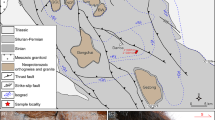Abstract
The Jilin H5 chondrite, the largest known stony meteorite in the world, with its No.1 fragment weighing 1770 kg. It contains submillimeter- to centimeter-sized FeNi metal particles/nodules. Our optical microscopic and electron microprobe analyses revealed that the formation of metal nodules in this meteorite is a complex and long-term process, The early stage is the thermal diffusion-caused migration and concentration of dispersed metallic material along fractures to form root-hair shaped metal grains during thermal metamorphism of this meteorite. The later two collision events experienced by this meteorite led to the further migration and aggregation of metallic material into the shock-produced cracks and openings to form larger-sized metal grains. The shock-produced shear movement and frictional heating occurred in this meteorite greatly enhanced the migration and aggregation of metallic material to form the large-sized nodules. It was revealed that the metal nodule formation process in the Jilin H5 chondrite might perform in the solid or subsolidus state, and neither melting of chondritic metal grains nor shock-induced vaporization of bulk chondrite material are related with this process.










Similar content being viewed by others
References
Bennett ME, McSween HY Jr (1996) Shock features in iron-nickel metal and troilite of L-group ordinary chondrites. Meteorit Planet Sci 31:255–264
Chen M, Xie XD, Wang DQ, Wang SC (2002) Metal-troilite-magnetite assemblage in shock veins of Sixiangkou meteorite. Geochim et Cosmochim Acta 66:3141–3149
Kong P, Xie XD (2003) Redistribution of elements in the heavily shocked Yanzhuang chondrite. Meteorit Planet Sci 38:739–746
Kong P, Ebihara M, Xie XD (1998) Reevaluation of formation of metal nodules in ordinary chondrites. Meteorit Planet Sci 33:993–998
Moreau JG, Schwinger S (2021) Heat diffusion in numerically shocked ordinary chondrites and its contribution to shock melting. Phys Earth Planet Interiors 310:106630. https://doi.org/10.1016/j.pepi.2020.106630
Ohno A (1987) Solidification: the separation theory and its practical applications. Springer-Verlag, Berlin Heidelberg, p p123
Ouyang ZY, Xie XD, Wang DD (1978) A model of the formation and evolution of the Jilin meteorite. Geochimica 1:1–11 (in Chinese with English abstract)
Pekeroglu TE (2012) Metal nodules and veins in L chondrites: Composition and origin. MS thesis on Geochemistry, The Florida State University, p. 96
Rubin AE (1999) Formation of large metal nodules in ordinary chondrites. J Geophys Res 104:30799–30804
Scott ERD (1973) Large metal nodules in ordinary chondrites (Abstract). Eos 54:1125–1126
Wang SS, McDougell I, Tetley N, Harrison TM (1980) 40Ar and 39Ar age and thermal history of the Jilin chondrite. Earth Planet Sci Lett 49:117–131
Widom E, Rubin AE, Wasson JT (1986) Composition and formation of metal nodules and veins in ordinary chondrites. Geochim et Cosmochim Acta 50:1989–1995
Wood JA (1967) Chondrites: their metallic minerals, thermal history, and parent planets. Icarus 6:1–49
Xie XD, Chen M (2020) Yanzhuang meteorite: mineralogy and shock metamorphism. Springer-Verlag and Guangdong Science and Press, Berlin Heidelberg, p 276
Xie XD, Huang WK (1991) Thermal and collision history of the Jilin (H5)and Qiangzhen (EH3) chondrites. Chin J Geochem 10:109–119
Xie XD, Wang DD (1992) The behavior of Fe-Ni metal during thermal metamorphism of the Jilin chondrite. Chin J Geochem 11:23–31
Xie XD, Chen M, Wang DQ (2001) Shock-related mineralogical features and P-T history of the Suizhou L6 chondrite. Eur J Mineral 13:1177–1190
Xie XD, Wang DD (1979) Thermometamorphic features of Jilin No. 1 meteorite: In: Proceedings of Jilin Meteorite Shower. Science Press, Beijing, pp. 184–191
Acknowledgements
This study is financially supported by the Science and Technology Planning Project of Guangdong Province, China, 2020B1212060055. The author wish to thank Dr. Hong Zhang of the State Key Laboratory of Continental Dynanics, North West University, for her help in LA-ICP-MS analysis.
Author information
Authors and Affiliations
Corresponding author
Ethics declarations
Conflict of interest
On behalf of all authors, the corresponding author states that there is no conflict of interest.
Rights and permissions
Springer Nature or its licensor (e.g. a society or other partner) holds exclusive rights to this article under a publishing agreement with the author(s) or other rightsholder(s); author self-archiving of the accepted manuscript version of this article is solely governed by the terms of such publishing agreement and applicable law.
About this article
Cite this article
Xie, X. Formation of FeNi metal nodules in the Jilin H5 chondrite, the largest stone meteorite in the world. Acta Geochim 42, 961–970 (2023). https://doi.org/10.1007/s11631-023-00627-5
Received:
Revised:
Accepted:
Published:
Issue Date:
DOI: https://doi.org/10.1007/s11631-023-00627-5




